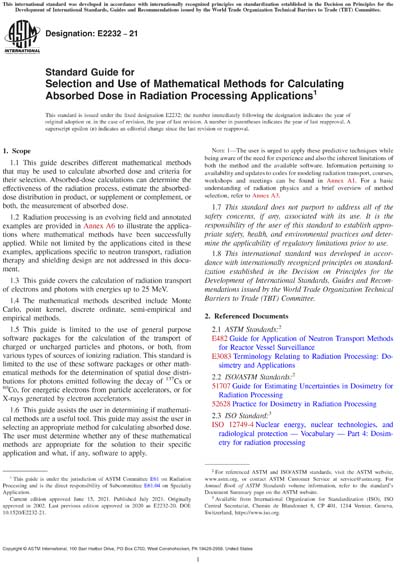Most recent
ASTM E2232-21
Standard Guide for Selection and Use of Mathematical Methods for Calculating Absorbed Dose in Radiation Processing Applications
1.1This guide describes different mathematical methods that may be used to calculate absorbed dose and criteria for their selection. Absorbed-dose calculations can determine the effectiveness of the radiation process, estimate the absorbed-dose distribution in product, or supplement or complement, or both, the measurement of absorbed dose.
1.2Radiation processing is an evolving field and annotated examples are provided in Annex A6 to illustrate the applications where mathematical methods have been successfully applied. While not limited by the applications cited in these examples, applications specific to neutron transport, radiation therapy and shielding design are not addressed in this document.
1.3This guide covers the calculation of radiation transport of electrons and photons with energies up to 25 MeV.
1.4The mathematical methods described include Monte Carlo, point kernel, discrete ordinate, semi-empirical and empirical methods.
1.5This guide is limited to the use of general purpose software packages for the calculation of the transport of charged or uncharged particles and photons, or both, from various types of sources of ionizing radiation. This standard is limited to the use of these software packages or other mathematical methods for the determination of spatial dose distributions for photons emitted following the decay of 137Cs or 60Co, for energetic electrons from particle accelerators, or for X-rays generated by electron accelerators.
1.6This guide assists the user in determining if mathematical methods are a useful tool. This guide may assist the user in selecting an appropriate method for calculating absorbed dose. The user must determine whether any of these mathematical methods are appropriate for the solution to their specific application and what, if any, software to apply.
Note 1:The user is urged to apply these predictive techniques while being aware of the need for experience and also the inherent limitations of both the method and the available software. Information pertaining to availability and updates to codes for modeling radiation transport, courses, workshops and meetings can be found in Annex A1. For a basic understanding of radiation physics and a brief overview of method selection, refer to Annex A3.
1.7This standard does not purport to address all of the safety concerns, if any, associated with its use. It is the responsibility of the user of this standard to establish appropriate safety, health, and environmental practices and determine the applicability of regulatory limitations prior to use.
1.8This international standard was developed in accordance with internationally recognized principles on standardization established in the Decision on Principles for the Development of International Standards, Guides and Recommendations issued by the World Trade Organization Technical Barriers to Trade (TBT) Committee.
Content Provider
ASTM International [astm]






